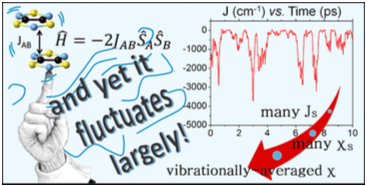Dynamical effects on the magnetic properties of dithiazolyl bistable materials
Dynamical effects on the magnetic properties of dithiazolyl bistable materials
S. Vela, M. Deumal, M. Shiga, J.J. Novoa, J. Ribas-Arino
Chem. Sci. 6 (2015) 2371.

The magnetic properties of molecule-based magnets are commonly rationalized by considering only a single nuclear configuration of the system under study (usually an X-ray crystal structure). In this computational work, we have compared the results obtained using such a static approach with those obtained by explicitly accounting for thermal fluctuations, and uncovered the serious limitations of the static perspective when dealing with magnetic crystals whose radicals undergo wide-amplitude motions. As a proof of concept, these limitations heve been illustrated for the magnetically bistable 1,3,5-trithia-2,4,6-triazapentalenyl (TTTA) material. For its high- temperature phase at 300 K, we have shown that nuclear dynamics induce large fluctuations in the magnetic exchange interactions (JAB) between spins (up to 1000% of the average value). These deviations result in a ~20% difference between the 300 K magnetic susceptibility computed by explicitly considering the nuclear dynamics and that computed using the X-ray structure, the former being in better agreement with the experimental data. The unveiled strong coupling between JAB interactions and intermolecular vibrations reveals that considering JAB as a constant value at a given temperature (as always done in molecular magnetism) leads to a flawed description of the magnetism of TTTA. Instead, the physically relevant concept in this case is the statistical distribution of JAB values. The discovery that a single X-ray structure is not adequate enough to interpret the magnetic properties of TTTA is also expected to be decisive in other organic magnets with dominant exchange interactions propagating through labile π-π networks.
